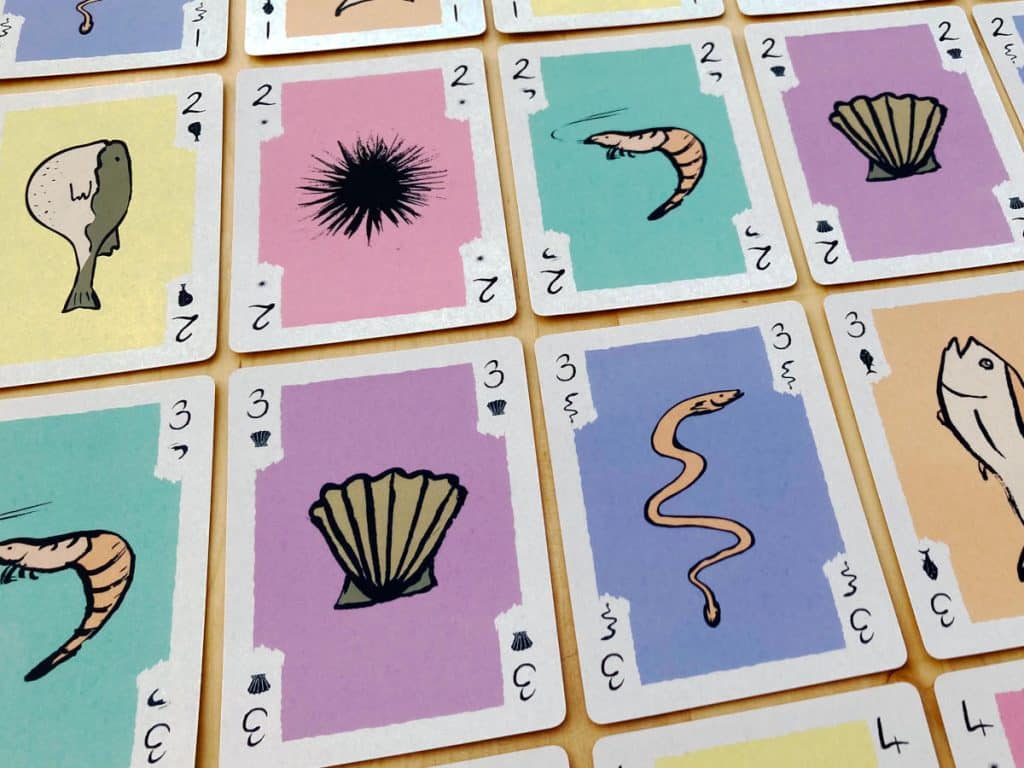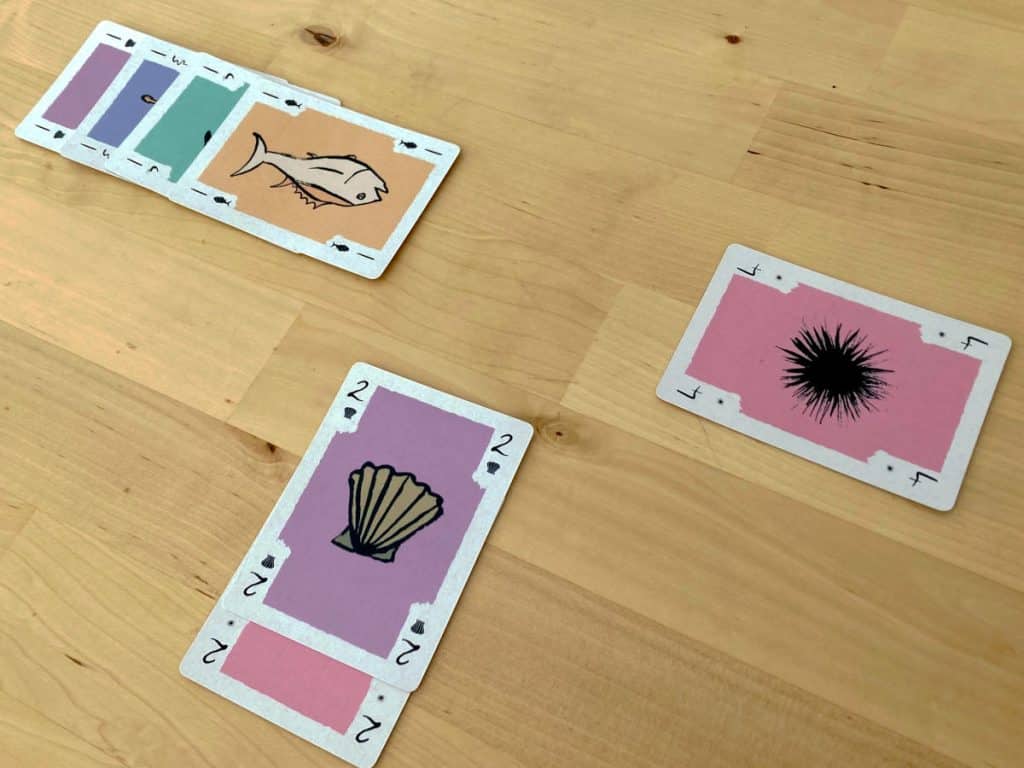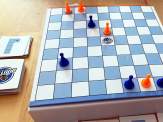| Release Date: 2025 | Players: 2-5 |
| Designer: Mike Petchey | Length: 15-30 minutes |
| Artist: Joss Petchey | Age: 8+ |
| Publisher: Huff No More | Complexity: 1.5 / 5 |
| Plastic (by weight): <1% | Air (by volume): <1% |
You have risen early to prepare your stall at Tsukiji Market. It won’t be long until the doors open and the aisles become a sea of people wanting to sample the wares. It’s going to be tough. The quality and variety of fish and shellfish on your stand are outstanding and should speak for themselves, but you can’t be sure until you have sold your whole Sakana Stack by Mike Petchey from Huff No More.
Listen to the Audio Version
Intro Music: Bomber (Sting) by Riot (https://www.
Sound Effects: bbc.co.uk – © copyright 2024 BBC
Music: Undercover Mission
A Tourist’s Impression
Sakana Stack is set against the backdrop of the famous fish market in Tokyo, where there are more than 480 different kinds of seafood and 270 types of other produce on offer. In a single day, around 1,600 tons of seafood worth 1.6 billion Yen are turned over at Tsukiji Market by around 900 vendors and over 60,000 employees. So, you get a sense of the immense pressure you, as the player, are expected to be under when you play this ladder-climbing card game.
As soon as you open the box and see the illustrations, which are all created from hand drawings made by Joss Petchey, who took inspiration from her own visit to the fish market on which the game is based, you know how much attention to detail has been paid to create this game and how much love as gone into it.
While Sakana Stack is clearly a game based on the experiences of a tourist, rather than a local, let alone a sakanari, a fish seller, you do feel as if you are handling various types of seafood and shellfish while you play the game. The six suits, or colours, are represented by pufferfish, sea urchins, prawns, clams, eels and of course, tuna, which are simple, but very effective line drawings.
In fact, Sakana Stack, as a product, is very simplistic and clean: a simple box of cards, a small rules sheet and very simple card and box illustrations. It feels like a European interpretation of highly effective Japanese product design, where everything is there for a reason.

Stacking It High
Despite the wonderfully tidy product design, the game itself is a little difficult to learn. Mind you, that seems to be the case for many ladder-climbing games. Even the rules for Scout and Odin are a bit confusing to begin with. Yet, as soon as you have played a round or two, it clicks. Sakana Stack is no different, yet while it does remind me of both of the aforementioned games, it has a few twists that really change how it plays.
If you have never played a ladder-climbing game before, let me run you through the basic principles. As I said, they’re a little hard to explain clearly, so bear with me.
In simple terms, one player plays a single card from their hand. The next player also has to play a single card, but of a higher value, or they can play two cards, but they also have to be a higher value. As they do so, the previous player’s cards are discarded. The third player can then also play two cards, or they can play three, as long as their value is higher. You keep going around the table until nobody can play cards of higher value.
Points are usually based on the number of cards discarded and games are usually played over several rounds, based on the number of players.
As I say, it sounds a bit confusing, but I think you can see why these games are called ladder-climbing games. Players keep trying to outbid each other and play cards that are more valuable than the previous set. I suppose you could call them bidding games instead, but you’re not completely free to bid anything, so it’s not quite the same thing.
Sakana‘s Ladder-Climbing
So Sakana Stack follows the same principles, but introduces a few changes to the basic concept. In this game, there is no need to play higher-value cards. You are allowed to match what is already on the table. That is a lovely twist that means you can have multiple players with the same value set in active play. If nobody can bid higher, everyone can benefit. However, when a player is able to go higher, everyone has to discard their cards. That creates huge swings in the game.
Instead of a single player hoping to score, like in other ladder-climbing games, in Sakana Stack, it’s possible that several people’s dreams are brutally crushed by a single player who stands to win big all by themselves. It really recreates the pressure sellers at Tsukiji Market must feel when they lose out to another vendor. It’s this simple change that creates a lot of tension, because the perceived safety in numbers simply isn’t there. A bigger fish can easily gobble up a whole shoal of smaller fish.
Another change is the so-called Catch of the Day, a single card that’s face-up in the middle of the table and that players can add to the cards they play on their turn. It’s a nice way of allowing players to improve their chances of outbidding their rivals. It’s not a huge change, but a lovely addition to make Sakana Stack more appealing to less competitive players. It makes the game just a little lighter and less cut-throat as it otherwise could have been.

The Stack in Sakana Stack
The last difference to other ladder-climbing games, and the change that gives the game its name, is that the cards you play are stacked on top of each other. The top card influences what the next player can do. So when you play your stack of fish, you need to consider in which order you lay out your cards.
That’s one of the most interesting changes that really differentiates Sakana Stack from other ladder-climbing games. While it’s not necessarily clear at first why you might want a certain fish on top, once you have played a few games, you realize the importance of this simple decision.
If you keep track of the cards that have been played and choose wisely which card to place on top, you can stop the other players from outbidding you, which is ultimately how you score the most points and win the game. Yet, while this decision is so important and can make such a huge difference, it’s also not so difficult that players will sit there for ages to work out what to do.
The mechanism that gives the game its name is something that creates a little bit of extra interest and increases the decision space just enough without causing analysis paralysis. It’s not something I’ve seen before in other games. It’s a relatively simple but important decision, which is really clever.
So, if you ever go to Tokyo to visit its amazing fish market, make sure you have the game in your pocket. Otherwise, if you want a ladder-climbing game that can easily compete with the likes of Scout and Odin, then take a closer look at Sakana Stack. I think you will really enjoy it. It’s certainly a game I’d happily play any time.
Keeping the blog running takes time and resources. So if you can chip in, that would be amazing.
Useful Links
- Sakana Stack: https://www.
huffnomore. co. uk/ sakanastack - Kickstarter page: https://www.
kickstarter. com/ projects/ sakanastack/ sakana-stack - Huff No More: https://www.
huffnomore. co. uk/ - BGG listing: https://boardgamegeek.
com/ boardgame/ 413838/ sakana-stack - Scout review: https://tabletopgamesblog.
com/ 2022/ 07/ 02/ scout-saturday-review/ - Odin review: https://tabletopgamesblog.
com/ 2024/ 03/ 30/ odin-saturday-review/
Videos
Transparency Facts
I feel that this review reflects my own, independent and honest opinion, but the facts below allow you to decide whether you think that I was influenced in any way. Please also read my Ethics Statement for more information.- I was given a free review copy of this game by the publisher.
- At the time of writing, I have not received financial support from the publisher or anyone working on their behalf.
Audio Version
Intro Music: Bomber (Sting) by Riot (https://www.
Sound Effects: bbc.co.uk – © copyright 2024 BBC
Music: Undercover Mission
Playlist
These are the songs I listened to while I was writing this review:






